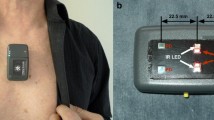Abstract
Hot thermistors and hot wires have been adapted to detect vascular and precordial pulses and heart sounds, respectively. The activity from the skin is amplified hydraulically by sealing a plastic cup over the area of interest and mounting the sensing elements in the centre of a small exit port plugged into a hole in the cup. Two thermistors can be mounted physically and electrically in such a way as to produce biphasic unbalancing of a Wheatstone bridge for sub-audio pulses. Fine heated wires sense higher frequency sound waves.
Records of external carotid, jugular venous and apex pulses and heart sounds are presented and comparisons are made with two standard transducers as evidence of the usefulness of the devices. A compact, low impedance transducer, rugged enough to withstand dropping from ceiling to floor, with a superior signal-to-noise ratio and insensitive to ambient sounds is evident.
Sommaire
Des thermistors échauffés et des fils échauffés ont été adaptés pour détecter des pouls vasculaires et précordiaux et les battements du coeur. L'activité de la peau est amplifiée hydrauliquement en fixant fermement une coupe en plastique sur la surface en question et en montant les éléments détecteurs dans le centre d'un petit point de sortie, branchés dans un orifice de la coupe. Deux thermistors peuvent être montés physiquement et électriquement d'une telle manière, de sorte que de produire un deséquilibre diphasé d'un pont de Wheatstone pour des pouls sous-acoustiques. Des fils fins, échauffés, détectent les ondes acoustiques de plus haute fréquence.
On présente des enregistremente de la carotide externe, les pouls veineux jugulaire et de l'apex et les bruits cardiaques et on fait des comparaisons avec deux transducteurs standard comme évidence de l'utilité des inventions. Il est évident que celui-ci est un transducteur compacte, d'impédance basse, bien fort, pour résister à la chute du plafond au plancher, ayant une proportion supérieure de signalisation du bruit et étant insensible aux sons ambiants.
Zusammenfassung
Hitzthermistoren und Hitzdrähte sind für Feststellung von Gefäss- und präkordialen Pulsschlägen beziehungsweise Herzschlägen angepasst worden. Die Aktivität von der Haut wird hydraulisch durch Versiegeln einer plastischen Kappe über dem Interessegebiet und durch Anbringen der Messfühlerelemente im Mittelpunkt einer kleinen Auslassöffnung und, eingesteckt in ein Loch in der Kappe, verstärkt. Es können zwei Thermistoren körperlich und elektrisch in solcher Weise angebracht werden, dass sie zweiphasische Unausgeglichenheit einer Wheatstone Brücke für subaudio Impulse erzeugen. Fein erhitzte Drähte fühlen Schallwellen höherer Frequenz.
Es werden Bänder äusserer, die Karotis betreffender Impulse, jugularer Venen- und Apexpulse und Herzgeräusche gebracht, und es werden zwei Standardumwandler als Beweis für die Nützlichkeit der Vorrichtungen verglichen. Ein kompakter Umwandler mit niedriger Impedanz, der genügend robust ist, um ein Fallen von der Decke zum Boden auszuhalten, mit einem überlegenen Störspannungsverhältnis und Unempfindlichkeit für Aussengeräusche ist einleuchtend.
Similar content being viewed by others
References
Abbott, J. A. (1969) The fidelity of the externally recorded human pulse.Am. J. med. Sci. 258, 40.
Benchimol, A. andDiamond, E. G. (1966) Apex cardiogram in the diagnosis of congenital heart disease.Am. J. Cardiol. 17, 63–71.
Benchimol, A. andDiamond, E. G. (1963) The normal and abnormal apex cardiogram.Am. J. Cardiol. 12, 368–383.
Berson, A. S. andPipeberger, H. V. (1966) Measurement of chest wall vibrations due to the activity of the heart.J. appl. Physiol. 21, 370–374.
Boicourt, O. W., Nagle, R. E. andMounsey, J. P. D. (1965) The clinical significance of systolic retraction of the apical impulse.Br. Heart J. 27, 379–391.
Diamond, E. G. (1964) Precordial vibrations.Circulation 30, 284–300.
Edmonds, R. E. (1966) An assessment of the utility of the resting apex cardiogram in the epidemiology of cardiovascular disease.Am. J. Cardiol. 17, 180–188.
Fowler, N. O. (1968)Cardiac Diagnosis. Harper & Roe, New York.
Hartman, H. (1960) The jugular venous tracing.Am. Heart J. 59, 698.
Hubbard, P. G. (1957) Operating manual for the IIHR hot-wire and hot-film anemometers. University of Iowa,Studies in Engineering, Bulletin 37.
King, L. V. (1914) On the convection of heat from small cylinder in a stream of fluid: Determination of the convection constants of small platinum wires with applications to hot-wire anemometry.Phil. Trans. of Roy. Soc. Lond. A214, 373–432.
Littauer, R. (1965) InPulse Electronics, p. 15. McGraw-Hill, New York.
Luisada, A. A. andMagri, G. (1952) The low frequency tracings of the precordium and epigastrium in normal subjects and cardiac patients.Am. Heart J. 44, 545–564.
Oestreicher, H. L. (1951) Field and impedance of an oscillating sphere in a visceolastic medium with an application to biophysics.J. acoust. Soc. Am. 23, 707–714.
Tafur, E., Cohen, L. S. andLevine, H. D. (1964a) Apex cardiogram in left ventricular outflow tract obstruction.Circulation 30, 392–399.
Tafur, E., Cohen, L. S. andLevine, H. D. (1964b) The normal apex cardiogram.Circulation 30, 381–391.
Tavel, M. D. (1967)Clinical Phonocardiography and External Pulse Recording. Year Book Medical Publishers, Inc., Chicago.
Von Gierke, H. E. (1959) Tansmission of vibratory energy through human body tissue.Proceedings of the First National Biophysics Conference, pp. 647–669. New Haven, Yale Univ. Press.
Author information
Authors and Affiliations
Additional information
Dr. Mahoney was the recipient of a cardiovascular training grant (5T-12HE-05729).
Rights and permissions
About this article
Cite this article
Laughlin, D.E., Mahoney, R.P. New phonocardiographic transducers utilizing the hot-wire anemometer principle. Med. & biol. Engng. 10, 43–55 (1972). https://doi.org/10.1007/BF02474567
Received:
Issue Date:
DOI: https://doi.org/10.1007/BF02474567



